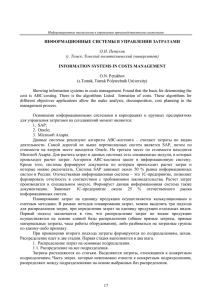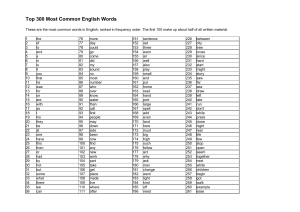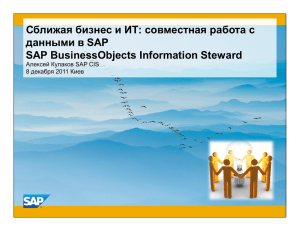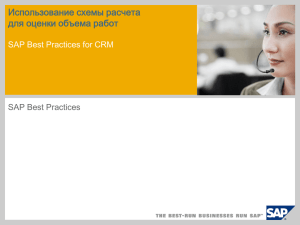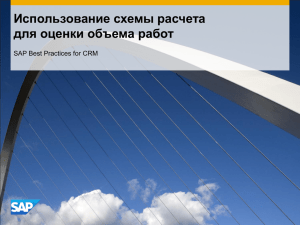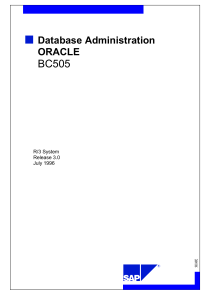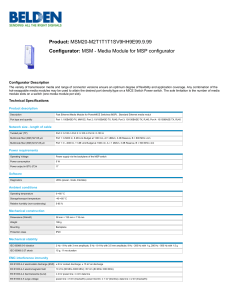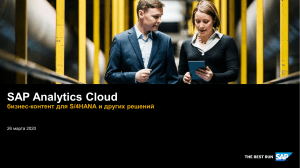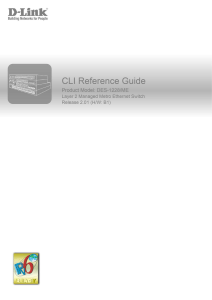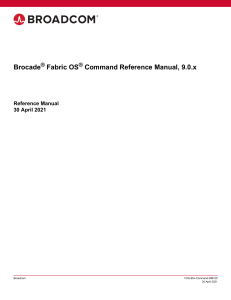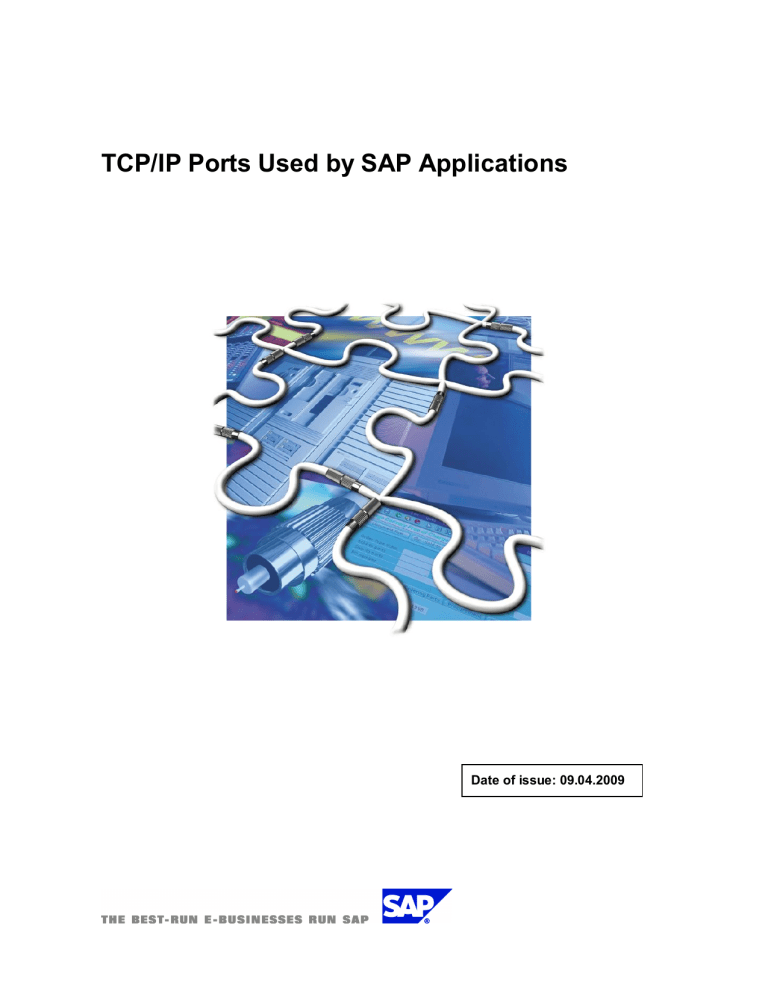
TCP/IP Ports Used by SAP Applications Date of issue: 09.04.2009 Copyright © Copyright 2009 SAP AG. All rights reserved. No part of this publication may be reproduced or transmitted in any form or for any purpose without the express permission of SAP AG. SAP AG Neurottstraße 16 69190 Walldorf Germany T +49/18 05/34 34 24 F +49/18 05/34 34 20 www.sap.com Notices The information contained here in may be changed without prior notice. SAP AG provides this publication "as is" without warranty of any kind, either express or implied, including, but not limited to, the implied warranties of non-infringement, merchantability or fitness for a particular purpose. SAP AG assumes no responsibility for any errors or omissions in these materials. SAP may make changes in the product and/or programs described in this publication at any time without notice. Trademarks Some software products marketed by SAP AG and its distributors contain proprietary software components of other software vendors. Microsoft®, WINDOWS®, NT®, EXCEL®, Word®, PowerPoint® and SQL Server® are registered trademarks of Microsoft Corporation. IBM®, DB2®, DB2 Universal Database, OS/2®, Parallel Sysplex®, MVS/ESA, AIX®, S/390®, AS/400®, OS/390®, OS/400®, iSeries, pSeries, xSeries, zSeries, z/OS, AFP, Intelligent Miner, WebSphere®, Netfinity®, Tivoli®, Informix and Informix® Dynamic ServerTM are trademarks of IBM Corp. in USA and/or other countries. ORACLE® is a registered trademark of ORACLE Corporation. UNIX®, X/Open®, OSF/1®, and Motif® are registered trademarks of the Open Group. Citrix®, the Citrix logo, ICA®, Program Neighborhood®, MetaFrame®, WinFrame®, VideoFrame®, MultiWin® and other Citrix product names referenced herein are trademarks of Citrix Systems, Inc. HTML, DHTML, XML, XHTML are trademarks or registered trademarks of W3C®, World Wide Web Consortium, Massachusetts Institute of Technology. JAVA® is a registered trademark of Sun Microsystems, Inc. JAVA EE™ is a registered trademark of Sun Microsystems, Inc. JAVASCRIPT® is a registered trademark of Sun Microsystems, Inc., used under license for technology invented and implemented by Netscape. SAP, SAP Logo, R/2, RIVA, R/3, SAP ArchiveLink, SAP Business Workflow, WebFlow, SAP EarlyWatch, BAPI, SAPPHIRE, Management Cockpit, mySAP, mySAP.com, and other SAP products and services mentioned herein as well as their respective logos are trademarks or registered trademarks of SAP AG in Germany and in several other countries all over the world. MarketSet and Enterprise Buyer are jointly owned trademarks of SAP Markets and Commerce One. All other product and service names mentioned are the trademarks of their respective owners. © SAP AG 2009 2 Network Ports used by SAP Contents 1 Introduction .................................................................................................................. 4 1.1 1.2 1.3 1.4 1.5 2 Status and Version History ...................................................................................... 4 Who Should Read This Document ........................................................................... 4 Resolving Port Conflicts........................................................................................... 4 Client Ports ............................................................................................................. 4 Source and Feedback ............................................................................................. 4 Port Table ..................................................................................................................... 5 2.1 2.2 SAP Applications..................................................................................................... 5 “Will Not be Used” Ports ........................................................................................ 13 3 Table Explanation....................................................................................................... 14 4 Details on Selected Servers....................................................................................... 15 4.1 SAP Application Server ......................................................................................... 15 © SAP AG 2009 3 Network Ports used by SAP 1 Introduction This paper provides a comprehensive list of ports used by SAP software. It can be useful for planning and configuring your network infrastructure according to SAP requirements. It can also be used to identify specific SAP network traffic for monitoring, prioritization or security purposes. 1.1 Status and Version History This paper is subject to continuous upgrade. Please check at SAP Developer Network (SDN) for the most recent version. 1.2 Who Should Read This Document Use this paper for planning, monitoring and troubleshooting the networking infrastructure for your SAP systems. It is written for anyone dealing with networking aspects of SAP systems. This includes: System architects and administrators Network planners and operators Network providers System integration consultants 1.3 Resolving Port Conflicts For a list of reserved (internet) ports, see http://www.iana.org/assignments/port-numbers. You should not use one of these services on the same host of your SAP system, if there are port conflicts with your specific SAP system installation. Note: Host network ports, which are required by a SAP system installation must not be used by any other services or programs on the same host. Otherwise the system will not operate correctly or installation will fail. In case SAP system ports of a choosen SAP Instance Number (e.g. 00) are already in use, please choose a different instance number or if arbitrary a different port during installation (see also Note 1169). Info: Many SAP TCP/IP port assignments exist since 1992. In a day when the list of well known ports ended with 1023. Later released SAP products will typically use a port range from 50000 and above during installation. Even so you may have to avoid port conflicts in this port range with other vendor programs if they run on the same host. 1.4 Client Ports This document contains no client ports. Client ports are allocated automatically by the operating system. No SAP software specifies a certain port for the client side of a connection. 1.5 Source and Feedback You can find this document and related ones on technical infrastructure topics in the SAP Developer Network SDN (TCP/IP Ports used by SAP) at. If you do not have access to that Web site send email to [email protected]. Please use this address also for any kind of feedback regarding this document. © SAP AG 2009 4 Network Ports used by SAP 2 Port Table The following table list SAP applications and functions listening on a port for incoming network requests. A description of the fields can be found in chapter 3. 2.1 SAP Applications © SAP AG 2009 5 Network Ports used by SAP Range (min-max) Default Fixed Rule External Service Port Number / Service Name Comment NetWeaver Application Server ABAP including Internet Connection Manager (ICM) Dispatcher 32NN 3200 3200-3299 + sapdpNN Gateway SAP Dispatcher, used by SAP GUI for Windows and Java + SAP gateway, used for CPIC and RFC communication sapdp00-sapdp99 33NN 3300 3300-3399 + sapgwNN Gateway + sapgw00-sapgw99 48NN 4800 sapgwNNs + ICM HTTP 80NN + ICM HTTPS 443NN ICM SMTP 25 + 4800-4899 sapgw00ssapgw99s + 8000 Free You can configure the system to use port number 80 after installation. Not active Free The port is not configured during installation. If you want to use HTTPS, you must configure it manually. Not active Free The port is not configured during installation. If you want to use SMTP, you must configure it manually. Only one instance per host should offer SMTP service. 3600 Free sapmsC11 sapms<any SID> Only CI (central instance) Service names can be reassigned in /etc/services to an arbitrary value after installation. + Message Server 36NN sapmsSID + SNC secured SAP gateway, used for CPIC and RFC communication, see SNC Users Guide for details, only encrypted communications. Please note, there is no related sapdpNNs (47xx) port Relevant only for releases prior to SAP NetWeaver 7.0 Message Server HTTP 81NN 8100 Free Only CI (central instance) Can be used to retrieve system information via HTTP + Relevant only for releases prior to SAP NetWeaver 7.0 Message Server HTTPS 444NN Not active Free Only CI (central instance) The port is not configured during installation. + Relevant only for releases prior to SAP NetWeaver 7.0 Central System Log UDP: 12NN, 13NN, 14NN, 15NN Not active Free Syslog (rslgsend) uses UDP for communications, see Note 25526 for deatils Only used on local host for signaling dispatcher, never seen on the network, disabled by default starting with 7.0 (gw/use_udp=1 will enable UDP port) + Purely internal ports Dispatcher 32NN/UDP 3200/UDP 3200-3299/UDP Gateway 33NN/UDP 3300/UDP 3300-3399/UDP ICM Admin detected automatically 65000 or next 65000 or less free lower port © SAP AG 2009 6 + Internal communication. Automatically uses the first free port from 65000 downwards. Port accepts connections only from localhost. Network Ports used by SAP Range (min-max) Default Fixed Rule External Service Port Number / Service Name Comment SAP NetWeaver Application Server Java JAVA EE Dispatcher (replaced by ICM in release SAP NetWeaver 7.1) HTTP 5NN00 + 50000 50000-59900 HTTP over SSL 5NN01 + 50001 50001-59901 IIOP initial context 5NN02 + 50002 50002-59902 IIOP over SSL 5NN03 + 50003 50003-59903 P4 5NN04 + 50004 50004-59904 P4 over HTTP tunneling 5NN05 50005 50005-59905 P4 over SSL 5NN06 + 50006 50006-59906 IIOP 5NN07 + 50007 50007-59907 Telnet 5NN08 + 50008 50008-59908 JMS 5NN10 + 50010 50010-59910 + NN = Instance number (00…99) Relevant only for releases up to and including SAP NetW eaver 7.0 Relevant only for releases up to and including SAP NetW eaver 7.0 JAVA EE Server ( internal ports) Server Join Port 5NN20 + x*5 50020 (server 0) 50020-59995 Server Debug Port 5NN21 + x*5 50021 (server 0) 50021-59996 Central Services for Java + + X = 0, 1, 2, 3, ...15 (number of server) X = 0, 1, 2, 3, ...15 (number of server) (Separate instance, default instance number 01) Enqueue Server Enqueue Server Port 32NN sapdpNN 3201 Enq. Replication 33NN sapgwNN 3301 Provides locking services for AS Java NN = Instance number (00…99) enque/encni/port 3200-3299 3300-3399 Replication of enqueue data for high availability NN = Instance number (00…99) Releases up to NW2004s enque/encni/repl_port. Relevant for releases up to and including SAP NetWeaver 7.0. Enq. Replication 5NN16 50116 50016, …, 59916 Replication of enqueue data for high availability NN = Instance number (00…99) enque/encni/repl_port Starting with NW2007 33NN sapgwNN 3301 3300-3399 Only relevant for releases SAP NetWeaver 7.1 and higher. Gateway Gateway Ports used by SAP gateway for CPIC and RFC communication Gateway 48NN sapgwNNs © SAP AG 2009 4800 4800-4899 + sapgw00ssapgw99s 7 + SNC secured SAP gateway, used for CPIC and RFC communication, see SNC Users Guide for details, only encrypted communications. Please note, there is no related sapdpNNs (47xx) port Network Ports used by SAP Range (min-max) Default Fixed Rule External Service Port Number / Service Name Comment Message Server Message Server Port 36NN HTTP 81NN HTTPS 444NN 3601 3600-3699 NN = Instance number (00…99) rdisp/msserv + 8101 8100-8199 ms/http_port_<n> + Not active 44400-44499 ms/https_port_<n> SAP NetWeaver AS Administrative Services Host Control Service SAPHostControl 1128 (+) 1128 50013-59913 + SAP Landscape Host integration service SAPHostControlS 1129 (+) 1129 50013-59913 + NN = Instance number (00…99) 50013-59913 + 50014-59914 + Start Service Start Service 50013 5NN13 NN = Instance number (00…99) + sapctrlNN Start Service 5NN14 + HTTP NN = Instance number (00…99) 50014 sapctrlsNN HTTPS Installation & upgrade tools SDM as part of AS instance 5NN17 5NN18 5NN19 50017 50018 50019 + Software deployment manager Only CI (central Instance) NN = Instance number (00…99) Only NW04 and NW2004s SL Controller 5NN17 5NN18 5NN19 Used for patch and upgrade services 50017 50018 50019 + *17: Administrator Communication *18: GUI port *19: http port NN = Instance number (00…99) NW2007 SAPinst 21212 21213 21212 21213 Free SAPinst on IBM AS400 iSeries 59975 59976 59975 59976 Free Upgrade - Monitoring - UA-server (HTTP) - R3up-process - UA-server 4238 4239 4240 4241 4238 4239 4240 4241 © SAP AG 2009 SAPinst on IBM iSeries needs these additional ports. Free 8 Network Ports used by SAP Range (min-max) Default Fixed Rule External Service Port Number / Service Name Comment Utilities SAProuter 3299 + SAP Web Dispatcher - HTTP port - HTTPS port chose freely chose freely + niping 3298 + SAPlpd 515 3299 Free Free Currently there is no installation procedure for SAP Web Dispatcher. Typical port for HTTP is 80. Typical port for HTTPS is 443 3298 Free SAP network test program 515 Free SAP printer spooler + printer RDBMS (Database Systems) MS SQL Chose freely 1433 1024 – 5000 Oracle listener 1527 1527 Free IBM DB6 (AIX) DB2 (OS/400) 50000 4402 / as-edrsql 50000 4402 Free 7200 / sql30 7210 / sql6 7269/sapdni72 7270/sdbnissl76 7575 / SDB 7200 7210 7269 7270 7575 Free liveCache (MaxDB) (formerly know as SAP DB) + + + + Port can be statically or dynamically allocated. If dynamic, port 1434/udp is also required. configured in listener.ora and tnsnames.ora Conflicts with SAP JAVA EE Engine with instance number 00. See relevant documentation on how to change this DB6 default port. In case of multiple MaxDB instances on one host the services are shared by all instances. Webtools NWDI (NetWeaver Development Infrastructure) DTR © SAP AG 2009 5NN15 50015 Design Time Repository (NW2004s and later) NN = Instance number (00…99) 9 Network Ports used by SAP Range (min-max) Default Fixed Rule External Service Port Number / Service Name Comment SAP NetWeaver AS Administrative Services ITS (Internet Transaction Server) AGate 39N0-39NM / sapavw00_Inst 3900 – 390M Free N determined at setup so that range free M = No agates –1 Inst = Name of ITS Instance MM 39N9 / sapavwmm_Inst 3909 Mapping Manager Free IGS (Internet Graphics Server) as part of Application Server Instance Multiplexer 4NN00 Portwatcher (Clients) 4NN01-4NN79 HTTP-ports 4NN80-4NN99 XI (SAP Exchange Infrastructure) JMS/JDBC/File Adapter Server 8200 (8201, … for multiple Adapter Installations on same host) + 8200 Free (Rules for this adapter not yet implemented) Port used for interactive browser access to configuration interface. Adapter does not belong to an SAP Application Server system. It can be installed on a host with XI server, or standalone. Usually only one instance needed, because individual JMS/JDBC and File Adapter instances live inside one serve process. JMS Adapter Chose freely 8210 Free Port for incoming data from XI server. JDBCAdapter Chose freely 8220 Free Port for incoming data from XI server. File Adapter Chose freely 8230 Free Port for incoming data from XI server. IPC (NW05 and CRM 5.0) (Internet Pricing and Configurator) IPC Dispatcher 4363 + 4363 Free Mobile client IPC Version 3.0 and 4.0 (Internet Pricing and Configurator) IPC Dispatcher 4444 IPC data loader IPC Server © SAP AG 2009 + 4444 Free 4445 Not active Free 9999, 9998, … 9999 Free 10 Mobile client Counting down from 9999 for each server process. Network Ports used by SAP Default Range (min-max) Fixed Rule External Service Port Number / Service Name Comment TREX (Text Retrieval and Information Extraction) Name Server 3NN01 30001 30001-39901 NN = TREX Instance; available for TREX 6.1, TREX 7.0, TREX 7.1 Pre Processor 3NNx2 30002 30002-39992 multiple servers possible x=server-index (0,1,2,…,9); available for TREX 6.1, TREX 7.0, TREX 7.1 Index Server 3NNx3 30003 30003-39993 multiple servers possible x=server-index (0,1,2,…,9); available for TREX 6.1, TREX 7.0, TREX 7.1 Queue Server 3NNx4 30004 30004-39994 multiple servers possible x=server-index (0,1,2,…,9); available for TREX 6.1, TREX 7.0, TREX 7.1 HTTP Server 3NN05 30005 30005-39905 available for TREX 6.1, TREX 7.0, TREX 7.1 GRMG service (Heartbeat) 3NN06 30006 30006-39906 optional; available as of TREX 7.0 RFC Server 3NN07 30007 30007-39907 Multithreaded RFC server with port 3NN07 available as of TREX 7.0 Cruiser 3NNx8 30008 30008-39908 multiple servers possible x=server-index (0,1,2,…,9); available as of TREX 7.1 Alert Server 3NN11 30011 30011-39911 available as of TREX 7.0 BackupServer 3NN17 30017 30011-39917 optional; available as of TREX 7.1 20003 Fixed + Communication between Admin Console application and MDM server 20004 Fixed + Inter Server communication (master/slave) 20005 Fixed + Communication between Admin Console application and MDM server MDM (Master Data Management) Admin Console 20003 Server to Server 20004 Admin Console 20005 Import Manager 20006 (+) 20006 Fixed + Communication between MDM Import Manager Service and its clients Syndicator Service 20007 (+) 20007 Fixed + Communication between MDM Syndicator Service and its clients Layout Server 31596, 31597, 31604 Fixed 31596, 31597, 31604 + Communication for print publishing between MDM Layout Server and its clients Layout Server Quark Express 31602 + Communication for print publishing between MDM Layout Server and Quark Express plugin Layout Server Adobe InDesign 31603 + Communication for print publishing between MDM Layout Server and Adobe InDesign plugin Layout Server 31596 + Communication for print publishing between MDM Layout Server and its clients MDM Server 2000-2002 © SAP AG 2009 + + + + + + + 31602 Fixed 31603 Fixed 31596 Fixed 2000-2002 2000-9997 11 3 consecutive ports in this range are required per each repository Network Ports used by SAP Default Range (min-max) Fixed Rule External Service Port Number / Service Name Comment TREX 6.0 (Text Retrieval and Information Extraction) Name Server 8355 8355 Free Pre Processor 8357 8357 Free Index Server 8351 8351 Free Queue Server 8352 8352 Free Http Server 8353 8353 Free Monitoring (GRMG) 8366 8366 Free Availability monitoring in CCMS Content Server Content Server 1090 + 1090 Free Cache Server 1095 + 1095 Free CSDM 20201 + Exchange Groupware Connector (DCOM) 135 / DCE CRM Lotus Domino - Connector - Proxy 62026 – 62029 62126 - 62129 Free Central Software deployment manager DCOM uses port 135 for the Service Control Manager which allocates a free port for the application. + 62026–62029 Free 62126-62129 Free The range comprises 4 Instances xxx26 for instance 1 up to xxx29 for instance 4. PAW (Performance Assessment Workbench of Knowledge Warehouse) PAW Communication Server 1099 PAW Servlet Engine 1089 http Free ODBC (e.g. MSSQL) Free DCOM 135 / DCE 1099 Free + 1089 Free + 80 Free IIS, configurable port on client side 1433 Free Port can be statically or dynamically allocated. If dynamic, port 1434/udp is also required. + Java RMI Server Business One © SAP AG 2009 Connection to license server. DCOM uses port 135 for the Service Control Manager which allocates a free port for the application. 12 Network Ports used by SAP 2.2 “Will Not be Used” Ports Port Number / Service Name Rule Default Range (min-max) Fixed Service External The following ports will not be used by standard SAP applications. They are intended for use with partner or other applications co-running on the same computers as SAP applications. To avoid any possible port number conflicts these additional applications are requested to make use of these “will not be used” ports. Comment Will Not be Used by SAP 63000 - 65535 © SAP AG 2009 13 + These ports will not be used by standard SAP applications Network Ports used by SAP 3 Table Explanation Service The name or identifier of the network services provided by SAP programs. Port Number / Service Name For each service, we list the port number associated with this service and if existent the rule used to compute port number and service name. Some ports have corresponding entries in /etc/services. If this is the case, we also list the service name. Some services use fixed port numbers, however most use a number that depends on some other value to allow multiple instances of the program running on the same host. Variable name convention (see below for explanation): NN is the instance number of the SAP Application Server instance (e.g. 32NN /sapdpNN means 3200 / sadp00 for instance no. 00) SID is the three letter system ID (e.g. sapmsSID means sapmsC11 for SAP system C11) All ports are TCP ports except where UDP is indicated. UDP is used only for internal communication ON THE SAME HOST, never for communication across a network. Most port numbers are configured by the installation procedure. In this case, the port number listed in the table is the one used by the installation procedure. Sometimes the installation procedure allows changing the port number. In this case, the value is the one presented as a default by the installation procedure. Other ports are not configured by the installation procedure. This is because the corresponding service can be used only after other manual configuration steps that cannot be carried out by the installation procedure. If a port is not automatically configured, this is indicated in the comment. If you want to use the corresponding service, you have to set the port manually. External The most relevant ports are the ones used by programs that connect to the system, for example, SAP GUI or Web browser or other programs that communicate with the system. Those ports are labeled "external" – there are relatively few of them. The other ports are used for internal communication between components of the system. Default The default port numbers are used all defaults presented by the installation procedure are accepted. Range The port range indicates the minimum and maximum port number for this service. Not all numbers in this range may be valid ports for this service. Fixed The column labeled "fix" indicates that SAP does not support changing this port number. If a conflict occurs, chose a different instance number to avoid occupied ports. Comments If appropriate, a brief explanation on the service, the port numbers used or the installation and configuration options. © SAP AG 2009 14 Network Ports used by SAP 4 Details on Selected Servers 4.1 SAP Application Server What are a System, an Instance and all that? An SAP Application Server system consists of one or more instances. An instance is a "server" in the sense that a user can connect to every instance individually. An instance typically consists of many running operating system processes that are connected by shared memory, TCP/IP connections on the local host and other means. All instances belonging to the same system are connected to the same RDBMS. A system has a three-letter name, the system identifier (SID). Instances of a system do not have to be configured identically; instead, different instances may offer different services. Some services are unique in a system, i.e. only one instance is configured to offer these services (e.g. Enqueue, Message Server). A system may have an instance called "central instance", which offers many of these unique services. Every instance has a number between 00 and 99, the so-called instance number (abbreviated by InstNr or NN to indicate the numerical value). The installation default is 00. If more than one instance is installed on the same host, they MUST have different InstNr. InstNrs are usually part of the Port numbers to ensure that there is no conflict between instances. An instance uses a number of TCP and UDP ports for internal communication. These ports are usually not configurable and not relevant for the "outside world". They are interesting only in the rare case when a conflict with other software on the same host occurs. The InstNr for an instance can be chosen freely. Different instances belonging to the same system can have different InstNrs. The InstNr is chosen during the installation. Most port numbers depend directly on the InstNr as shown by the table below. Some of the port numbers are merely suggested values that can be overridden during the installation procedure, some are generated automatically but can be changed using configuration tools after the installation as completed and some are fixed in the sense that SAP does not support changing these ports in any way. SAP Application Server Kernel The 80NN, 443NN port convention for HTTP(S) ports of the ICM does not comply with the spirit of the HTTP standard, which specifies port 80 for HTTP. We have chosen this convention to make sure that SAP Application Serveris able to start up correctly after installation. For productive servers, especially in the Internet, you should change these values. In the future, the installation procedure will already have an option to change these ports. The port scheme for JAVA EE server processes implies a maximum of 7 server processes per instance. If this should not be sufficient, the port scheme can easily be modified to allow more server processes. Java EE Engine HTTP communication is handled by ICM, which forwards requests to JAVA EE engine. Therefore, the HTTP port is used only for internal communication, and the HTTPS port is not used at all. JAVA EE server handles other protocols, e.g. RMI, directly. Standalone Java EE Engine The SAP Java EE engine can also be installed standalone without the Kernel part of the SAP Application Server. This implies that JAVA EE Engine now handles HTTP and HTTPS requests directly. © SAP AG 2009 15 Network Ports used by SAP
